A variety of physiological indicators have been used to show that TM produces very deep rest, even though it is only practised for 20 minutes at a time. This allows you to ‘recharge’ and build up energy for the day.
Scientific research published in Psychosomatic Medicine and the International Journal of Neuroscience has shown that TM produces high level of EEG coherence. In other words, waves in the left and right hemispheres of the brain start to work in synchrony.
This increased coherence has been shown in other studies to correlate to a wide variety of benefits, including:
- Increased fluency of verbal creativity (r=.71)
- Increased efficiency in learning new concepts (r=.50)
- Higher verbal IQ and decreased neuroticism (r=.63)
- Increased neurological efficiency as measured by faster recovery of the paired H-reflex (r=.60)
It has also been found that during TM the percentage of the brain used to respond to stimuli increases.
To find out more please click one of the links below:
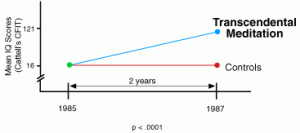 Students at Maharishi International University in Fairfield, Iowa, who regularly practised Transcendental Meditation, increased significantly in intelligence over a 2-year period, compared to control subjects from another Iowa university.
Students at Maharishi International University in Fairfield, Iowa, who regularly practised Transcendental Meditation, increased significantly in intelligence over a 2-year period, compared to control subjects from another Iowa university.
This finding corroborates the results of two other studies showing increased IQ in Maharishi International University students.
*Reference I: Transcendental Meditation and improved performance on intelligence-related measures: A longitudinal study, Personality and Individual Differences 12: 1105-1116, 1991. Reference II: Longitudinal effects of the Transcendental Meditation and TM-Sidhi programme on cognitive ability and cognitive style, Perceptual and Motor Skills 62: 731738, 1986.
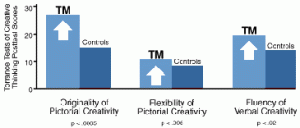 This study used the Torrance Tests of Creative Thinking to measure figural and verbal creativity in a control group and in a group that subsequently learned the Transcendental Meditation technique.
This study used the Torrance Tests of Creative Thinking to measure figural and verbal creativity in a control group and in a group that subsequently learned the Transcendental Meditation technique.
On the posttest 5 months later, the Transcendental Meditation group scored significantly higher on figural originality and flexibility and on verbal fluency.
*Reference I: The TM technique and creativity: A longitudinal study of Cornell University undergraduates, Journal of Creative Behavior 13: 169-190, 1979. Reference II: A psychological investigation into the source of the effect of the Transcendental Meditation technique, (Ph.D. dissertation, York University) Dissertations Abstracts International 38, 7-B: 33723373, 1978.
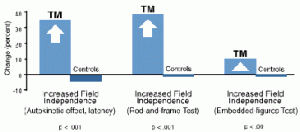 Field independence has been associated with a greater ability to assimilate and structure experience, greater organisation of mind and cognitive clarity, improved memory, greater creative expression, and a stable internal frame of reference.
Field independence has been associated with a greater ability to assimilate and structure experience, greater organisation of mind and cognitive clarity, improved memory, greater creative expression, and a stable internal frame of reference.
The results show that practice of the Transcendental Meditation technique develops greater field independence. This improvement in Transcendental Meditation meditators is remarkable because it was previously thought that these basic perceptual abilities do not improve beyond early adulthood.
*Reference I: Influence of Transcendental Meditation upon autokinetic perception, Perceptual Motor Skills 39: 1031-1034, 1974. Reference II: Longitudinal effects of the Transcendental Meditation and TM-Sidhi programme on cognitive ability and cognitive style, Perceptual and Motor Skills 62: 731738, 1986.
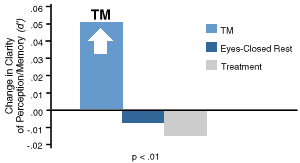 College students instructed in Transcendental Meditation displayed significant improvements in performance over a 2-week period on a perceptual and short-term memory test involving the identification of familiar letter sequences presented rapidly.
College students instructed in Transcendental Meditation displayed significant improvements in performance over a 2-week period on a perceptual and short-term memory test involving the identification of familiar letter sequences presented rapidly.
They were compared with subjects randomly assigned to a routine of twice-daily rest with eyes closed, and with subjects who made no change in their daily routine.
*Reference: Meditation and flexibility of visual perception and verbal problem solving, Memory and Cognition 10: 207215, 1982.
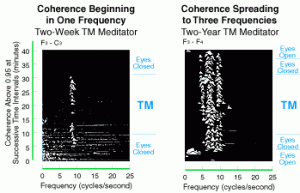 EEG coherence increases between and within the cerebral hemispheres during Transcendental Meditation. EEG coherence is a quantitative index of the degree of long-range spatial ordering of the brain waves.
EEG coherence increases between and within the cerebral hemispheres during Transcendental Meditation. EEG coherence is a quantitative index of the degree of long-range spatial ordering of the brain waves.
The chart on the left shows that for a 2-week meditator, EEG coherence increased during the period of meditation. The chart on the right, of a 2-year meditator, shows high levels of coherence even before meditation began, spreading of coherence to high and lower frequencies about half way through the meditation period, and continuing high coherence even into the eyes-opened period after meditation.
*Reference I: The Coherence Spectral Array (COSPAR) and its application to the study of spatial ordering in the EEG, Proceedings of the San Diego Biomedical Symposium 15: 1976. Reference II: Electrophysiologic characteristics of respiratory suspension periods occurring during the practice of the Transcendental Meditation programme, Psychosomatic Medicine 46: 267-276, 1984.
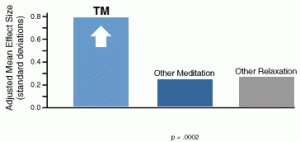 Self actualisation refers to realizing more of one’s inner potential, expressed in every area of life. A statistical meta-analysis of all available studies-of 42 independent studies-indicated that the effect of Transcendental Meditation on increasing self-actualisation is markedly greater than that of other forms of meditation and relaxation. This analysis statistically controlled for length of treatment and quality of research design.
Self actualisation refers to realizing more of one’s inner potential, expressed in every area of life. A statistical meta-analysis of all available studies-of 42 independent studies-indicated that the effect of Transcendental Meditation on increasing self-actualisation is markedly greater than that of other forms of meditation and relaxation. This analysis statistically controlled for length of treatment and quality of research design.
*Reference: Transcendental Meditation, self-actualisation, and psychological health: A conceptual overview and statistical meta-analysis, Journal of Social Behavior and Personality 6: 189248, 1991.
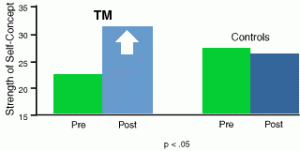 One month after beginning Transcendental Meditation, subjects experienced an improved self-concept in comparison to before learning the technique.
One month after beginning Transcendental Meditation, subjects experienced an improved self-concept in comparison to before learning the technique.
Transcendental Meditation participants developed a more strongly defined self-concept and also came to perceive their “actual self” as significantly closer to their “ideal self.” No similar changes were observed for matched controls.
*Reference I: Effects of Transcendental Meditation on self-identity indices and personality, British Journal of Psychology 73: 5768, 1982. Reference II: Psychological research on the effects of the Transcendental Meditation technique on a number of personality variables, Gedrag: Tijdschrift voor Psychologie (Behavior: Journal of Psychology) 4: 206218, 1976.
 This three-month study of managers and employees who regularly practised the Transcendental Meditation technique in a Fortune 100 manufacturing company and a smaller distribution-sales company showed that Transcendental Meditation practitioners displayed more relaxed physiological functioning, a greater reduction in anxiety, and reduced tension on the job, when compared to control subjects with similar job positions in the same companies.
This three-month study of managers and employees who regularly practised the Transcendental Meditation technique in a Fortune 100 manufacturing company and a smaller distribution-sales company showed that Transcendental Meditation practitioners displayed more relaxed physiological functioning, a greater reduction in anxiety, and reduced tension on the job, when compared to control subjects with similar job positions in the same companies.
*Reference: A prospective study of the effects of the Transcendental Meditation programme in two business settings, Anxiety, Stress and Coping: International Journal 6: 245262, 1993.
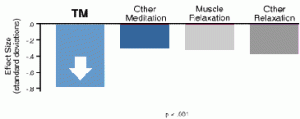 A statistical meta-analysis conducted at Stanford University of all available studies-146 independent outcomes-indicated that the effect of the Transcendental Meditation programme on reducing anxiety as a character trait was much greater than that of all other meditation and relaxation techniques, including muscle relaxation.
A statistical meta-analysis conducted at Stanford University of all available studies-146 independent outcomes-indicated that the effect of the Transcendental Meditation programme on reducing anxiety as a character trait was much greater than that of all other meditation and relaxation techniques, including muscle relaxation.
This analysis also showed that the positive Transcendental Meditation result could not be attributed to subject expectation, experimenter bias, or quality of research design.
*Reference: Differential effects of relaxation techniques on trait anxiety: A meta-analysis, Journal of Clinical Psychology 45: 957974, 1989.

